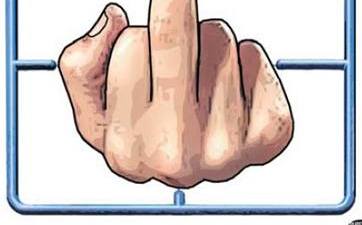Twenty years (and about a month) ago, the students of the Vysoka Skola Strojni a Elektrotechnicka v Plzne (VSSE, the College of Machines and Electrotechnics in Plzen) participated in the demonstrations against Communist Party rule by creating a huge banner that read “U krmlecu” and affixing over the front door of the West Bohemian headquarters of the Communist Party on Moskevska Street in Plzen. As I understand it ( and I would appreciate any further insight) “U krmlecu” translates roughly as “At the feeding trough,” a criticism of the crudness and corruption of the party, phrased in reference to the Czech habit of naming pubs with “U” i.e. “at” something or other: “At the Three Fishermen” or “At the Golden Tiger.” This was a time of posters on walls–and from the picture it looks like the headquarters had already been a target–but the sheer scale and cleverness of this one is worth remembering. The best part of the story, as I remember having it told to me, is that in order to affix the banner the students enlisted the help of municipal workers in a lamp-post fixing truck who were happy to oblige.
This is far from the only example of courage and wit from 1989 but for me it is one of the most memorable, because I received the picture from my then-student Ales Vlk (a force of nature in his own right and expert on EU higher education policy) and because when I first arrived in Plzen in 1990 to teach English, this building was my first destination: in a supremely ironic turnaround that seemed entirely appropriate in a country where a dissident playwright had become president, the regional party headquarters had by then become the main administration building of the VSSE and its fifth and sixth floors (hammer and sickle stained glass window still intact) had been turned over to teachers of English, mostly young Americans and Canadians.
Two minor footnotes.
- First, in a transformation that is perhaps just as appropriate, the storefront next to this building became the location of Plzen’s first McDonalds (the family of McDonald’s pioneer Ray Kroc came from the Plzen area and the Plzen McDonalds boasts a bronze bust of Kroc himself). It is also an entirely appropriate symbol of the Czech Republic’s changes that the former communist party headquarters and university headquarters has now reverted (in my understanding) to its original function: a bank. But, perhaps because history tends to repeat itself or because doing so would be just too expensive, or because they don’t even know it’s there, the new owners have yet to remove the 4 meter Red Communist party star which stood on the roof of the building in the 1980’s and is still visible in the most recent Google Maps image:
- Second, and relevant in almost no possible way, I need to relay my constant delight at the “U”/”At the” mode for naming bars. Of all of them in Prague, my favorite was a bar across from the restaurant U Zpěváčkůsouth of the National Theatre in Prague. It’s become the Kavarna Paleta now but it used to be a dive with good, cheap beer you could bring out side and drink while sitting on the sidewalk (no fancy chairs or tables). It was at this particular establishment that my friend John Gridley and I watched as a young guy holding a dachshund or beagle heaved it to his girlfriend so that he could go in and buy himself a beer. From then on it became, for us, the Dog-Toss Pub or, even better, U vyhozeneho psa.
View Larger Map












